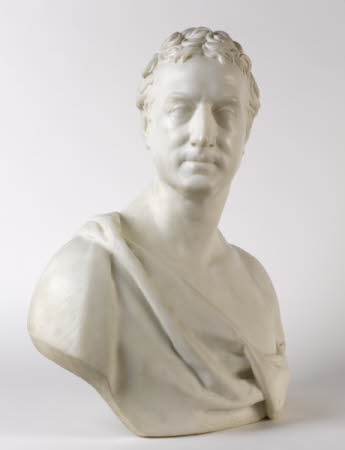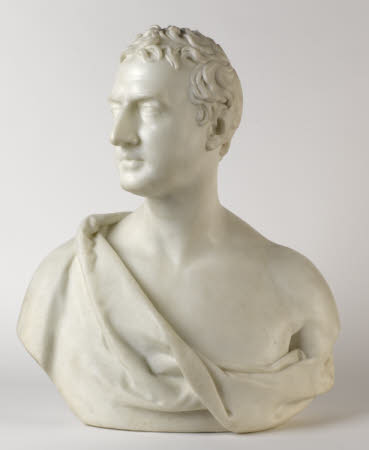Portrait bust of Robert Stewart, 2nd Viscount Castlereagh, later 2nd Marquess of Londonderry
after Sir Francis Legatt Chantrey RA (Norton, nr. Sheffield 1781 – London 1841)
Category
Art / Sculpture
Date
c. 1822 - 1840
Materials
Marble
Measurements
630 x 540 x 305 mm
Place of origin
London
Order this imageCollection
Mount Stewart, County Down
NT 1542341
Summary
Sculpture, marble; portrait bust of Robert Stewart, 2nd Viscount Castlereagh & 2nd Marquess of Londonderry, KG, GCH, MP (1769–1822); after Sir Francis Chantrey (1781-1841); c. 1822. A portrait by Sir Francis Chantrey of the politician and statesman Lord Castlereagh, who was instrumental in enabling the passing of the Act of Union by the Irish Parliament. Subsequently, Castlereagh became one of the key participants in the negotiations at the Congress of Vienna following the defeat of Napoleon Bonaparte. The bust is a copy of the signed and dated portrait bust made by Chantrey in 1821, formerly at Londonderry House.
Full description
A marble portrait bust of Robert Stewart, 2nd Viscount Castlereagh & 2nd Marquess of Londonderry, after an original by Sir Francis Legatt Chantrey RA (Sheffield 1781 – London 1841). The subject is depicted at bust length, a toga-like drapery wrapped around him and with the left shoulder left bare, facing to his right, his hair short. Presumably formerly mounted on a socle, but this is now missing. Robert Stewart, the only surviving son from the first marriage of the 1st Marquess of Londonderry, is the key figure in the history of the Londonderry family. In 1790 he entered Parliament as MP for County Down, enjoying a meteoric rise through British politics and becoming Prime Minister in all but name. In 1798, as Chief Secretary to the Lord Lieutenant of Ireland, Stewart was wrongly blamed for the violence used to suppress the rebellion that year in Ireland. However, he supported the union of of Ireland with Britain and was subsequently instrumental in ensuring the passing of the 1801 Act of Union. Except for the period 1809-12, Castlereagh was a member of the British cabinet continuously from 1802 until his death in 1822 by suicide, driven by overwork, anxiety and hostility engendered by his efforts on behalf of Catholic Emancipation. In 1812 he returned to government as Foreign Secretary, in which post he helped to bring the Napoleonic wars to a conclusion, before playing a key part in the Congress of Vienna, which aimed to reach a settlement with France and to create a balance of power to ensure peace in Europe. Lord Castlereagh had a reputation as a staunch reactionary and tended to excite violent reactions in others, enthusiasm from some, condemnation on the part of others. In 1821, just over a year before his own demise, he succeeded as 2nd Marquess of Londonderry, on the death of his father. Francis Chantrey is one of the greatest of English sculptors, certainly the finest portrait sculptor working in Britain in the nineteenth century. Born in modest circumstances near Sheffield, he was largely self-taught and, unlike many other young artists, did not have the chance as a young man to study in Italy, although he would travel to Italy in 1819. He began his career as a woodcarver in Sheffield, but was living in London by 1809, when he married. Chantrey’s first major success came with a portrait bust, of the Rev. J. Horne Tooke, exhibited at the Royal Academy in 1811 (Fitzwilliam Museum, Cambridge). He would in the course of his career make numerous church and public monuments in marble and in bronze, but it was as a maker of portrait busts that he was especially admired by his contemporaries. Chantrey had a particular ability to express the softness of flesh through the hard material of marble, whilst retaining a sense of the bone structures beneath. His contemporary J.T. Smith praised his busts for ‘their astonishing strength of natural character, for the fleshy manner in which he has treated them, which every real artist knows to be the most difficult part of the Sculptor’s task.’ (J.T. Smith, Nollekens and his times, 2 vols., London 1920, I, p. 227). Likewise his friend George Jones wrote that ‘His busts were dignified by his knowledge and admiration of the antique, and the fleshy, pulpy appearance he gave to marble seems almost miraculous when operating on such a material; the heads of his busts were raised with dignity, the throats large and well turned, the shoulders ample, or made to appear so; likeness was preserved and natural defect obviated.’ (Jones 1849, p. 172). The portrait bust of Lord Castlereagh was the first of a series of images made by Chantrey of Tory politicians, which would be regularly shown at the Royal Academy. The prime version of the portrait was commissioned in 1820 by Castlereagh himself (Yarrington, Lieberman, Potts and Barker 1991-1992, pp. 145-46, no. 125b) and was then exhibited at the Royal Academy in 1821 (no. 1132). Signed and dated 1821, it became one of a group of six portrait busts, mainly depicting members of the Londonderry family, that was long displayed in the Inner Hall at Londonderry House, mounted on yellow scagliola pedestals. The group also included another version of the bust of Castlereagh, unsigned but inscribed ‘Viscount Castlereagh, 1821’. Both these busts were among the sculptures from Londonderry House sold at auction in 1962, following the sale and demolition of the family’s London residence. The 1821 bust is now in the Yale Center for British Art in New Haven (Inv. B1977.14.3), whilst the second bust was subsequently in the collection of Ian Grant. Chantrey’s original plaster model is in the Ashmolean Museum, Oxford (Inv. WA1842.81; Penny 1992, no. 689; Eustace 1997, pp. 88-90, no. 6) and drawings for the portrait are in the National Portrait Gallery. Numerous other replicas of the portrait survive, including in marble: National Portrait Gallery (NPG 687, dated 1822); Royal Collection (RCIN 35411, commissioned 1828); Wellington Museum, Apsley House, London; Travellers’ Club, London. In National Trust collections, there is a marble example at Powis Castle (NT 1185532) and another in plaster at Ickworth (NT 852242). It is likely that most of these versions were made by Chantrey’s studio. The version now at Mount Stewart was formerly at the Londonderry’s English country seat, Wynyard Park in Co. Durham. It was possibly ordered by the third Marquess of Londonderrry as part of the furnishings of Wynyard, built between 1820 and 1840. The bust is of some quality, with the hair sharply cut in the marble, and the drapery enlived with texturing. Like many of Chantrey’s portrait busts of male sitters, his portrait of Lord Castlereagh depicts the sitter dressed not in contemporary apparel, but instead in a toga-like drape evoking the antique. Here, however, the unusual device of leaving the left shoulder bared seems to have been a deliberate choice on the part of the famously handsome Castlereagh. The sculptor’s friend and early biographer George Jones wrote of how King George IV, the Duke of Sussex and Castlereagh were all ‘so struck with Chantrey’s power of appreciating every advantage of form, that they bared their chests and shoulders, that the sculptor might have every opportunity that well-formed nature could present.’ (Jones 1849, p. 172). The naked shoulder lends the portrait a somewhat sensuous air, whilst the portrait’s studied informality is augmented by the sculptor’s turning of the head to the sitter’s right, creating the sense that he is engaged in conversation. The Duke of Wellington’s friend Mrs Arbuthnot saw the unfinished bust in Chantrey’s studio in March 1821, writing in her diary that ‘It was not quite finished, but it will be wonderfully like and has just the beautiful expression of his countenance when he speaks.’ (Arbuthnot 1950, I, p. 85, 26 March 1821). Chantrey’s early biographer John Holland described suggested that after his return from Italy, Chantrey made four of his very finest busts: Castlereagh, the painter Thomas Phillips, William Wordsworth and Sir Walter Scott. It is possible at Mount Stewart to compare Chantrey’s portrait of Castlereagh, created in 1821, the last year of the sitter’s life, with the 1809 bust of him aged 40 by Joseph Nollekens (1737-1823), the leading portrait sculptor of the previous generation (NT 1220131). Jeremy Warren August 2022
Provenance
Wynyard Park, Statue Hall; on loan from the Estate of the Marquess of Londonderry
Credit line
Estate of the Marquess of Londonderry
Makers and roles
after Sir Francis Legatt Chantrey RA (Norton, nr. Sheffield 1781 – London 1841), sculptor
References
Wynyard 1949: Inventory and Valuation of the Contents of Wynyard Park, Co. Durham, the property of the Most Honourable the Marquess of Londonderry… deceased. Prepared for the purpose of probate by H. Clifford-Smith. 1949, p. 35, Statue Hall. Jones 1849: George Jones, Sir Francis Chantrey, RA: Recollections of his Life, Practice and Opinions, London 1849, p. 172. Holland 1851: John Holland, Memorials of Sir Francis Chantrey, Sheffield 1851, p. 277. Smith, John Thomas,. Nollekens and his times 1920. Arbuthnot, Harriet, 1793-1834 journal of Mrs. Arbuthnot 1820-1832 / 1950., Vol. I, p. 85 Yarrington, Lieberman, Potts and Barker 1991-1992: Alison Yarrington, Ilene D. Lieberman, Alex Potts and Malcolm Barker, ‘An Edition of the Ledger of Sir Francis Chantrey R.A., at the Royal Academy, 1809-1841, The Volume of the Walpole Society, 1991-1992, pp. 145-6, no. 125b Penny 1992: Nicholas Penny, Catalogue of European Sculpture in the Ashmolean Museum, 1540 to the Present Day, 3 vols., Oxford 1992, no. 689 Roscoe 2009: I. Roscoe, E. Hardy and M. G. Sullivan, A Biographical Dictionary of Sculptors in Britain 1660-1851, New Haven and Yale 2009, p. 249, no. 422.




